
Guests
- Angela Davisauthor, activist and professor at University of California, Santa Cruz.
- Lennox HindsAssata Shakur’s attorney. He has represented her since 1973. He is a professor of criminal justice at Rutgers University.
One day after the exiled former Black Panther Assata Shakur became the first woman named to the FBI’s Most Wanted Terrorists list, we’re joined by another legendary African-American activist, Angela Davis, as well as Shakur’s longtime attorney, Lennox Hinds. Davis, a professor at the University of California, Santa Cruz, is the subject of the recent film, “Free Angela and All Political Prisoners.” She argues that the FBI’s latest move, much like its initial targeting of Shakur and other Black Panthers four decades ago, is politically motivated. “It seems to me that this act incorporates or reflects the very logic of terrorism,” Davis says. “I can’t help but think that it’s designed to frighten people who are involved in struggles today. Forty years ago seems like it was a long time ago. In the beginning of the 21st century, we’re still fighting around the very same issues — police violence, healthcare, education, people in prison.” A professor of criminal justice at Rutgers University, Hinds has represented Shakur since 1973. “This is a political act pushed by the state of New Jersey, by some members of Congress from Miami, and with the intent of putting pressure on the Cuban government and to inflame public opinion,” Hinds says. “There is no way to appeal someone being put on the terrorists list.”
Transcript
AMY GOODMAN: “A Song for Assata” by Common. This is Democracy Now!, democracynow.org, The War and Peace Report. I’m Amy Goodman, with Juan González.
JUAN GONZÁLEZ: Well, we continue to look at the case of Assata Shakur, legendary figure within both first the Black Panther Party and then the Black Liberation Army. On Thursday she became the first woman ever to make the FBI’s Most Wanted Terrorists list. In addition, the FBI and the state and New Jersey doubled the reward for her capture to $2 million.
AMY GOODMAN: To talk about her case, we are joined by two people. Here in New York, Lennox Hinds, Assata Shakur’s longtime attorney, he has represented her since 1973. He’s a professor of criminal justice at Rutgers University. And in Chicago, we’re joined by the world-renowned author, activist, scholar, Angela Davis, also a professor at University of California, Santa Cruz. And she is the subject of a recent film, Free Angela and All Political Prisoners. Angela Davis and Lennox Hinds both wrote forewords to the book Assata: An Autobiography.
We invited the FBI to join us on today’s program, but they did not respond to our request. about Assata Shakur.
I wanted to start with you, Lennox Hinds. The significance of Assata Shakur being put on the FBI’s terrorists list, the first woman ever to be added to the most wanted list?
LENNOX HINDS: My view on this is that this is a disingenuous act on the part of—driven by the state of New Jersey and particularly the state police. As you know, for decades, the state police have wanted and demanded that the Cuban government extradite Assata Shakur to the United States. There is no extradition policy between Cuba and the United States. Just to deal with this in context, the Cuban government, pursuant to international law—that is, particularly the refugee convention—have granted Assata Shakur political asylum. Now, what is the basis for that? It is if an individual has a well-grounded fear that if they return to the country from which they left, they would either be persecuted or prosecuted based upon their political beliefs or/and their race or religion. Now, this is not a new concept. There have been numerous individuals who have left the United States and went to foreign countries, allies of the United States, where those countries have refused to extradite them. France, for example, in the 1970s, there were Black Panthers who hijacked planes and went to France. Now, both France and the United States have extradition treaties. Not only that, France signed the 1963 Tokyo Convention, the 1970 Hague Convention and the 1973 Montreal Convention, with the United States. All of these are international agreements that require countries, host countries, that are holding individuals—who have hijacked planes—to extradite them or try them. France, after conducting their own independent review of these Black Panthers, refused to extradite them to the United States based upon France’s assessment that if they would be returned, they would be subject to political and racial repression. So, I say that the Cubans’ position is well grounded in international law.
Now, why today is Assata Shakur now being branded a terrorist? If we look at the definition of terrorism, what is it? It is the use or the threat of use of force against a civilian population to achieve political ends. What happened in the case of Assata Shakur? You have heard, in her own words, this woman was a political activist. She was targeted by whom? J. Edgar Hoover and the FBI in a program that was called COINTELPRO. That program was unveiled by whom? Frank Church, Senator Frank Church, in the 1970s. He chaired the Senate Intelligence Committee. That committee determined that the FBI was using both legal, but mostly illegal, methods—to do what? In the FBI’s own words, they wanted to discredit, to stop the rise of a black messiah—that was the fear of the FBI—so that there would not be a Mau Mau, in their words, uprising in the United States. And they were, of course, referring to the liberation movement that occurred in Kenya, Africa. Now, the FBI carried out a campaign targeting not only the Black Panther Party. They targeted SCLC. They targeted Martin Luther King. They targeted Harry Belafonte. They targeted Eartha Kitt. They targeted anyone who supported the struggle for civil rights, that they considered to be dangerous.
It is in that context we need to look at what happened on the New Jersey Turnpike in 1973. What they call Joanne Chesimard, what we know as Assata Shakur, she was targeted by the FBI, stopped. And the allegation that she was a cold-blooded killer is not supported by any of the forensic evidence. If we look at the trial, we’ll find that she was victimized, she was shot. She was shot in the back. The bullet exited and broke the clavicle in her shoulder. She could not raise a gun. She could not raise her hand to shoot. And she was shot while her hands were in the air. Now, that is the forensic evidence. There is not one scintilla of evidence placing a gun in her hand. No arsenic residue was found on her clothing or on her hands. So, the allegation by the state police that she took an officer’s gun and shot him, executed him in cold blood, is not only false, but it is designed to inflame.
JUAN GONZÁLEZ: But, Mr. Hinds, before we get into more of the details of the case, this whole issue of 40 years later—
LENNOX HINDS: Yeah.
JUAN GONZÁLEZ: —suddenly branding her a terrorist and also insisting that she is a threat to the United States government at this time, could you talk about the significance—
LENNOX HINDS: Yes.
JUAN GONZÁLEZ: —of that declaration?
LENNOX HINDS: Well, I believe that we have to look at it in the context of what has just happened in Boston. I think that with the massacre that occurred there, the FBI and the state police are attempting to inflame the public opinion to characterize her as a terrorist, because the acts that she was convicted of has nothing to do with terrorism. The acts that she was convicted of, if you look at the evidence, she was convicted of aiding and abetting, and therefore was present during the shootout. The FBI and the state police’s theory was that Sundiata Acoli shot Officer Foerster. That was their theory during his trial.
JUAN GONZÁLEZ: One of the people in the car with her, that—
LENNOX HINDS: One of the people in the car, yeah.
AMY GOODMAN: Well, let me read the FBI press release, and you can respond to how they describe it. And we want to bring Angela Davis in, as well. This was their press release yesterday describing the May 2nd, 1973, shooting. They said, “On May 2, 1973, Chesimard and a pair of accomplices were stopped by two troopers for a motor vehicle violation on the New Jersey Turnpike. At the time, Chesimard—a member of the violent revolutionary activist organization known as the Black Liberation Army—was wanted for her involvement in several felonies, including bank robbery.
“Chesimard and her accomplices opened fire on the troopers. One officer was wounded, and his partner—Trooper Foerster—was shot and killed at point-blank range. One of Chesimard’s accomplices was killed in the shoot-out and the other was arrested and remains in jail.
“Chesimard fled but was apprehended.”
That’s their statement yesterday.
LENNOX HINDS: Right. Also in their statement that I read, the superintendent of state police claimed that Assata Shakur took the Officer Foerster’s weapon and shot him while he was on the ground. There is not one scintilla of evidence at the trial attesting to that. In fact, as I was saying before, she was incapable of lifting her hands, much less firing a weapon.
Now, you asked what is the reason for this allegation at this time. We have to remember that 10 years ago, a little over 10 years ago, the then-governor of the state of New Jersey, former Governor Christie Todd Whitman, she had issued and posted a $1 million bounty for Assata Shakur. Today it has been doubled. But we believe that putting Ms. Chesimard, putting Assata Shakur on the FBI’s 10 most wanted list is designed to inflame the public and to characterize her as a terrorist, when none of the acts alleged relates to terrorism. In fact, of all of the charges that have been leveled against her in New York, case after case, she was acquitted, or the charges were dismissed. There was insufficient evidence to support any of the charges.
AMY GOODMAN: Well, let’s just—in 1971, armed robbery case was dismissed; 1971, she was acquitted of bank robbery; 1972, hung jury; 1972, kidnap of drug dealer, acquitted; and then several other cases dismissed. Angela Davis, you’re in Chicago right now to give a major address tonight at the University of Chicago. Can you talk about this news of Joanne Chesimard, Assata Shakur, being—now being put on the top 10 wanted terrorists list, the first woman ever to be put on this list?
ANGELA DAVIS: Well, first of all, it was a major shock to hear that Assata Shakur has become the first woman to be added to the FBI’s Most Wanted Terrorists list and then to learn that they’re adding another million dollars to the reward, the bounty. Really, it seems to me that this act incorporates or reflects the very logic of terrorism. I can’t help but think that it’s designed to frighten people who are involved in struggles today. Forty years ago seems as if it were a long time ago, four decades; however, in the 21st century, at the beginning of the 21st century, we’re still fighting around the very same issues—police violence, healthcare, education, people in prison, and so forth. So I see this as an attack not so much on Assata herself, although of course she deserves to be brought home. She deserves to be able to live out her life, and with justice and peace. It was wonderful that you allowed people, through this program, to hear Assata’s words, because, 40 years later, people really don’t know the details of the case and are not aware of the extent to which she was targeted by the FBI by the COINTEL Program, as Lennox pointed out. And it’s amazing that in 2013, where she is living in Cuba as a political refugee, having given—having been given political asylum by Cuba, she is still pursued. And actually, this is an invitation for anyone to travel to Cuba illegally and to kidnap her and bring her back to the United States, if not shoot her dead. This is—as I said, was an extremely shocking revelation.
JUAN GONZÁLEZ: And, Angela Davis, the government statement that she remains a threat to the United States, the implication being that she’s somehow still trying to organize attacks on the country, it really is mind-boggling. It’s one thing to say, “We have a case here of someone who’s still wanted.” It’s another thing to say that they’re still a threat to the United States, when there’s been no indication over the last 30, 40 years that Assata Shakur has been involved in any type of movements or organizations directed against the United States government.
ANGELA DAVIS: Well, see, there’s always this slippage between what should be protected free speech—that is to say, the advocacy of revolution, the advocacy of radical change—and what the FBI represents as terrorism. You know, certainly, Assata continues to advocate radical transformation of this country, as many of us do. You know, I continue to say that we need revolutionary change. This is why it seems to me that the attack on her reflects the logic of terrorism, because it precisely is designed to frighten young people, especially today, who would be involved in the kind of radical activism that might lead to change.
But you’re absolutely right, Assata is not a threat. If anything, this is a—this is a vendetta. She is innocent, and many of us have looked at the evidence. And as Lennox pointed out, there’s no way that she could have possibly been the person who killed Foerster, because she had her hands up and was shot in the back with her hands in the air and could not have used a gun at that time. And so, to represent her as a person who continues to be a threat to the U.S. government in the way that is described is, it seems to me, an effort to strike fear in the hearts of young people who would be active in the struggles that are represented historically by Assata and struggles that continue today. Struggles against police violence, for example, continue. The fact—consider the fact that so many people have been killed by the police in recent years. And I’m thinking about Kimani Gray in New York. I’m thinking about Alan Blueford in Oakland, of course Oscar Grant in Oakland. I’m thinking about—there’s some 63 people who were killed last year in Chicago by the Chicago police.
AMY GOODMAN: Lennox Hinds, this issue of what this allows the U.S. government to do? To be on the Most Wanted Terrorists list, I mean, does this mean the government could move in, like they moved in on Osama bin Laden, for example? Could—
LENNOX HINDS: I think what Angela said was right on point. It is an open invitation, not only with respect to the United States government, but for anyone, in Cuba or elsewhere, to become a vigilante, to go there and to not only apprehend and bring her back, or to kill her. So it’s an open invitation. And, you know, when we—Cuba is accused of harboring terrorists. And when we look at the role of the United States and the United States government vis-à-vis Cuba, the United States government and the CIA have encouraged, trained, sent individuals to not only disrupt the Cuban economy by killing tourists, placing bombs in restaurants and hotels, but to assassinate Fidel Castro, and individuals who admitted that they were involved in the downing of a Cuban airliner in 1973. I’m talking about Posada Carriles. Here was a man who made the open admission, trained by the CIA, harbored by the United States. When he was found in the United States, did the United States prosecute him for those crimes? No. They, on a pretext, prosecuted him for lying to the FBI, all right? and acquitted him of that.
AMY GOODMAN: I wanted to go back to Assata Shakur when she was here, when she was imprisoned. This is a clip of a documentary, Eyes [of] the Rainbow: The Assata Shakur Documentary. In this, Assata Shakur talks about her experience in prison.
ASSATA SHAKUR: Prisons are big business in the United States, and the building, running and supplying of prisons has become the fastest-growing industry in the country. Factories are moving into the prisons, and prisoners are forced to work for slave wages. This super-exploitation of human beings has meant the institutionalization of a new form of slavery. Those who cannot find work on the streets are forced to work in prison.
AMY GOODMAN: That was Assata Shakur in the film Eyes [of] the Rainbow: The Assata Shakur Documentary. Lennox Hinds, you went to court to change the prison conditions that Assata Shakur was in after she was arrested. Describe what happened to her after she was arrested. I mean, she was near death.
LENNOX HINDS: She was near death. She was chained to her hospital bed. After she recovered, she was placed in an all-male prison. She was under 24-hour surveillance by male prison guards who were watching and monitoring her very personal needs during that time period. We went into federal court and challenged the conditions of her confinement, where she was kept in solitary confinement for two years. We won that case. And they—that is, the Middlesex County Correctional Department were forced to place her in a women’s facility. But that was a horrible situation amounting to torture.
AMY GOODMAN: Your case went to the Supreme Court, how you were treated in the court?
LENNOX HINDS: Well, there’s the illusion—you know, I wrote a book called Illusions of Justice. There is the illusion that we have justice in the United States. I made the mistake of thinking that lawyers enjoyed a First Amendment right, and I called a press conference, and I criticized the trial judge at the trial and said that the case was a legalized lynching. And before you know it, I was facing disbarment. They attempted to disbar me by bringing charges against me. And they asked me to come and explain myself. I refused. I sued the judge. I sued the prosecutor. And I sued all of the members of the Ethics Committee, forced them to come to my office. I took their depositions. And the case went all the way up to the United States Supreme Court. United States Supreme Court said, “Well, Hinds could not have understood the seriousness of the charges; otherwise, he would not have made that sort of statement.” They sent the case back to New Jersey. The New Jersey Supreme Court agreed and tossed it out.
AMY GOODMAN: You’re still a lawyer today, and you—
LENNOX HINDS: I’m still a lawyer today.
AMY GOODMAN: And you represented South African President Nelson Mandela?
LENNOX HINDS: That’s correct, yeah.
JUAN GONZÁLEZ: I wanted to ask you about the trial itself, the only trial for which Assata Shakur has ever been convicted.
LENNOX HINDS: Convicted, that’s correct.
JUAN GONZÁLEZ: In New Jersey. You write in the preface, “It had been and is my view that it was the racism in Middlesex County, fueled by biased, inflammatory publicity in the local press before and throughout the trial, fanned by the documented government lawlessness, that made it possible for the white jury to convict Assata on the uncorroborated, contradictory, and generally incredible testimony of trooper Harper, the only other witness to the events on the turnpike.” There was one other state trooper, Harper, who survived the confrontation and who was the main witness against Assata.
LENNOX HINDS: Yeah, but Harper ran away during the shootout, came back, and his story was conflicted and contradictory. And—
JUAN GONZÁLEZ: He originally claimed that he had seen her pull out a gun.
LENNOX HINDS: That’s right, but there was no evidence to support that.
JUAN GONZÁLEZ: Right.
LENNOX HINDS: As I said, no fingerprints on any weapon. They claim that she fired a weapon. There were no arsenic powder marks or residue on her clothing or on her hands, etc. No forensic evidence.
JUAN GONZÁLEZ: And he later also admitted that the original reports and testimony that he had given was wrong on that.
LENNOX HINDS: Was wrong, that’s right. That’s right.
JUAN GONZÁLEZ: And yet she was still convicted.
LENNOX HINDS: Yeah, she was convicted. And it was an all-white jury. The pretrial publicity was such that people in Middlesex County and people from the northern part of New Jersey believed then, and believe now, that she is guilty. The mere fact that she was in the car meant that she was guilty. And in fact, the instructions to the jury—because there was no evidence of her doing any shooting, the instructions to the jury was that if you find that she was present and supported the action of the people who did the shooting, she can be found guilty as a principal. And that is under the felony murder rule.
AMY GOODMAN: Now, Angela Davis, I wanted to go to your own case years ago, because it’s coming up with a new film, your own history. I wanted to play a trailer to the new documentary Free Angela and All Political Prisoners.
REPORTER: Philosophy Professor Angela Davis admitted that she is a member of the Communist Party.
UNIDENTIFIED MAN 1: Hoover put her on the top 10. Everybody had a file on her.
UNIDENTIFIED WOMAN: Her first lecture drew 2,000 students.
FANIA DAVIS: Angela’s education is now being put into practice.
UNIDENTIFIED MAN 2: Angela Davis purchased four guns.
ANGELA DAVIS: There is a conspiracy in the land. It’s a conspiracy to wipe out the black community as a whole.
UNIDENTIFIED MAN 3: Well, I think she’s trying to overthrow our system of government, and she admits that.
PRESIDENT RICHARD NIXON: The actions of the FBI in apprehending Angela Davis, a rather remarkable story.
REPORTER: The U.S. district court judge set bail at $100,000.
FANIA DAVIS: She knows that the movement to free all political prisoners is growing every day.
GOV. RONALD REAGAN: This entire incident was a deliberate provocation.
ANGELA DAVIS: They wanted to break me. They wanted me to respond.
UNIDENTIFIED WOMAN 2: There was enormous feeling for Angela everywhere in the world.
SALLYE DAVIS: We know that she is innocent.
RALPH ABERNATHY: We want to tell that pharaoh in Washington to let Angela Davis go free.
UNIDENTIFIED MAN 4: What they’re doing to her is an exaggerated form of what happens every day to black people in this country.
PROTESTERS: Free Angela! Free Angela! Free Angela!
ANGELA DAVIS: What does it mean to be a criminal in this society?
UNIDENTIFIED WOMAN 3: They are not going to kill her. They’re not going to imprison her. We’re going to free her. We’re going to win her freedom.
AMY GOODMAN: You’ve been listening to an excerpt of a trailer, Free Angela and All Political Prisoners, that has just been finished, quite an interesting film by Shola Lynch. Angela Davis, if you could share your own experience that you went through? It was right about the same time that Assata Shakur was going through what she was.
ANGELA DAVIS: Well, yes, it was. And I find it really interesting that the FBI decided to focus quite specifically on black women, because somehow they feared, it seems to me, that the movement would continue to grow and develop, particularly with the leadership and the involvement of black women. I was rendered a target, an ideological target, in the same way that Assata Shakur was called the “mother hen” of the Black Liberation Army. The way in which she was represented became an invitation for racists and everyone who assented to the repressive behavior of the U.S. government to focus very specifically on her, to focus their hate, to focus vendettas on her. And I really find it surprising that when the grandchildren of those who were active in the late ’60s and early ’70s are becoming involved in similar movements today, there is this effort to again terrorize young people by representing such an important figure as Assata Shakur as a terrorist.
And let me say that I was quite surprised that in the aftermath of the Boston Marathon bombing, where, before the Tsarnaev brothers were discovered to be the alleged perpetrators, there was an attempt to represent the person who planted the bombs as either a black man or a dark-skin man with a hoodie, I believe—this racialization of what is represented as terrorism is an attempt to bring the old-style racism into conversation with modes of repression in the 21st century.
And there’s one other point that I would like to make. And that is that at the same time that Assata Shakur is being designated the first woman ever on the 10 Most Wanted Terrorists list, the Cuban Five, Cuban citizens who attempted to prevent terrorist attacks on Cuba, continue to be held in prison in the United States.
JUAN GONZÁLEZ: Lennox, I’d like to ask you about this whole issue of the FBI and COINTELPRO that you mentioned earlier on the role that the FBI has historically played in terms of persecution of black activists and revolutionaries, beginning obviously with an incident that shaped Assata Shakur’s thinking: the murder of Fred Hampton.
LENNOX HINDS: That’s correct.
JUAN GONZÁLEZ: And when you talk about people who—everyone who was involved in an incident, there were many FBI and Chicago police folks involved in the murder of Fred Hampton. Could you talk about that?
LENNOX HINDS: No question about it, no question. There were literally hundreds of victims of the FBI COINTELPRO program. These are individuals who were killed, assassinated. The instructions that were given by the FBI to not only their field agents, but also to the local police, it was essentially shoot on sight. And the case of Fred Hampton was a clear case where the—again, the investigations that were conducted showed that of the dozens of bullets that were fired, at least 40 bullets that were fired, only one, if that many, were fired by the Panthers who were in the house.
AMY GOODMAN: And then, of course, Fred Hampton was the head of the Black Panther Party in Chicago.
LENNOX HINDS: Fred Hampton was in bed.
AMY GOODMAN: He in bed, he and Mark Clark killed on December 4th, 1969.
LENNOX HINDS: That’s right. They were killed. Fred Hampton was in bed, and he was shot while lying in bed. And so, again, the victims of the Counter Intelligence Program were individuals who were not only falsely accused, falsely arrested, but many of them were assassinated.
AMY GOODMAN: Finally, you are Assata Shakur’s lawyer. Is there anything you can do as a lawyer right now with her being named to the terrorism list? Is there any way to appeal this?
LENNOX HINDS: No, there is no way to appeal someone being put on the terrorists list. This is a political act, and this is an act that has been done by—being pushed by the state of New Jersey by some members of Congress from Miami, and with the intent of putting pressure on the Cuban government and to inflame public opinion.
AMY GOODMAN: Well, I want to thank you both very much for being with us. Lennox Hinds, Assata Shakur’s attorney, he’s represented her since 1973, professor of criminal justice at Rutgers University. He also represented Nelson Mandela in the United States. And Angela Davis, joining us from Chicago, author, professor and activist, a professor at the University of California, Santa Cruz, joining us from Chicago.
We’re going to break and then come back for a short segment on President Obama in Mexico. Stay with us.

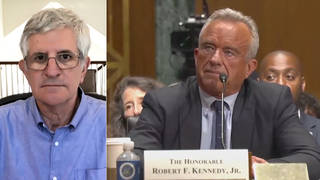
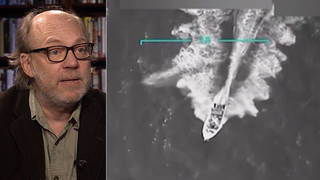
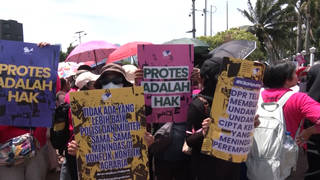
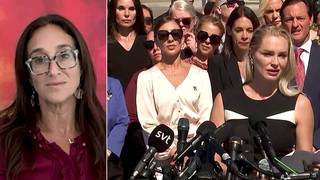
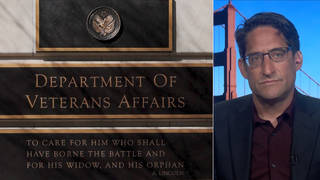
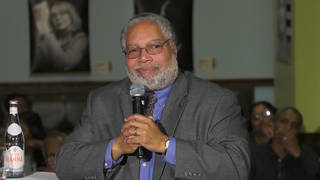

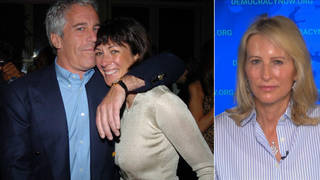

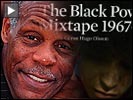
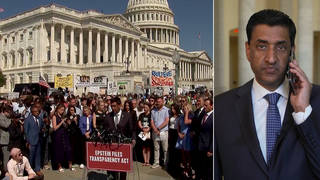
Media Options